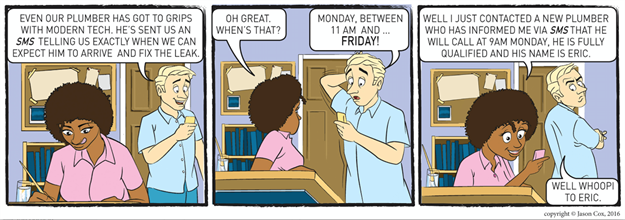SMS Isn't Dead, It's Alive and Well

As the number one preferred communication channel for consumers, text messaging has become top of mind as a way for businesses in all industries to engage with their customers. In response, the following is the first in a five-part series helping companies gain a deeper understanding of SMS and the best way to implement it as part of a comprehensive mobile engagement strategy.
Texting is the number one preferred channel of millennials for notifications from businesses. As SMS continues to be a critical factor in the future of customer engagement along with the growth of millennials, it's not only important for brands to understand SMS, it's vital to their relevance.
You're invited to follow "Sam," who is the lead character in this SMS-based comic series, for insight into the various life situations he encounters that reveal the many ways SMS can be used today. Topics will range from the serious - to the seriously hilarious.
Before the series unfolds, let's give you a bit of background on Sam. He is an SMS expert, passionate about enhancing customer experience for businesses worldwide. Sam lives with his wife, Jane, his two kids and his grandmother, known as Gran. We're introduced to Sam as he interviews for a new role at ABC Communications, a global company looking to bring in a customer experience expert to help them improve customer satisfaction levels and increase their Net Promoter Score. Sound like a familiar need?
In this installment, Sam meets his potential new boss, Mr. Sneed, as he goes for his first interview at ABC Communications. It turns out that SMS wasn't the first customer engagement solution they had in mind.
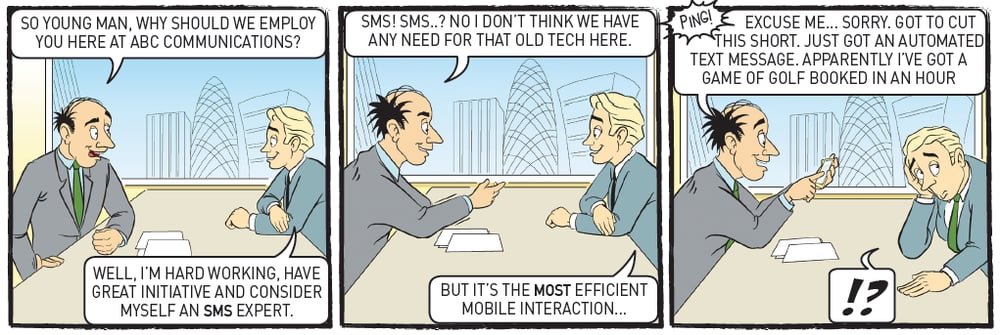
Later that day, Sam gets a text message from the company's recruitment team...

Sam's experiences bring to light very common scenarios for using SMS in today's business-to-consumer world. In fact, Fortune 2000 companies like ABC Communications are creating simple and effective text messaging solutions for engaging with their target audiences. Despite the growing adoption of the mobile channel, research shows that millennials are only receiving 0-5 text messages from businesses a week, with 20 percent not receiving any text at all.
The aim of this series is to open business leaders' eyes to the massive missed opportunity for customer engagement via SMS messaging. Join in for next month's installment featuring more SMS use cases that help deliver better business outcomes and higher levels of customer service.
SMS: Simple, Efficient and Effective
We last caught up with our lead character Sam at his first interview with ABC Communications, where he's applying for a customer engagement position as the company's SMS expert. We'll now join Sam for his second follow-up interview with his potential new boss, Mr. Sneed. Like so many makers in charge of implementing strategies that evoke better overall customer experience, it looks like Mr. Sneed knows that theoretically he should be using SMS, but with so much already on his plate, he doesn't know where to start.

As Mr. Sneed learns, SMS stands for short message service-the most versatile and widely used mobile communications channel in the world. As SMS is now used by enterprises large and small around the globe, ABC Communications needs to catch up with the times and leverage the power of SMS to deliver such services as appointment reminders, payment reminders, fraud alerts, password PINs, shipping notifications, and IT alerts, to name a few. With SMS having a 98 percent open rate, with the majority of consumers opening the message within 90 seconds of receiving them, companies like ABC Communications can ensure their message is not only delivered, but received.
Knowing Your Audience
Sam's expertise on SMS for business served him well-in the next comic strip we get insight into a morning conversation between Sam and his wife, Jane. Sam is excited to find out he's been offered the job with ABC Communications, but needs to let his current boss know of the pending change. What's the best channel for him to communicate the news-in-person, email, phone, or perhaps, SMS?
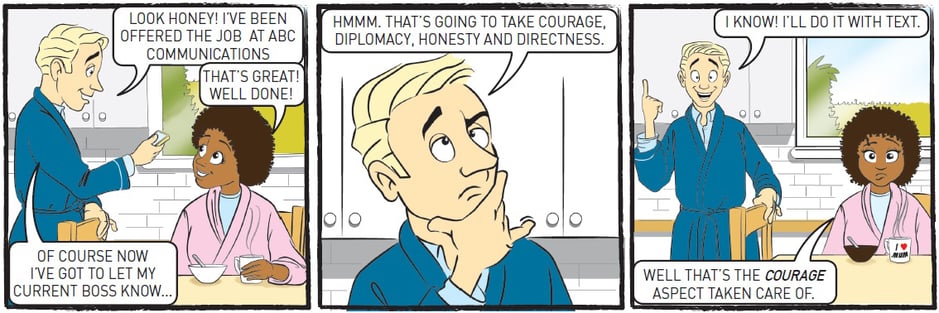
Virtually every mobile phone supports SMS, making it the most widely accessible channel for communicating with key audiences. While SMS is the most effective mobile engagement platform for enterprises, like all channels, it's best when used in the right context, at the right time and personalized for the receiver.
As for a two-week notice, while it's important to get in writing, it may not be the most relevant situation for SMS.
Massive Misconception: SMS Vs. Email
SMS is a great tool to use and interact with employees, consumers or clients, with over 6 billion people globally having SMS technology enabled and ready to use on their mobile handsets - be it smartphones or not. Overall, 95 percent of all SMS text messages are read, versus only 20 percent of emails.
However, most global businesses are missing the mark when it comes to customers' preferred form of communication, focusing their efforts on more traditional channels like voice calls and email over SMS.
This month's edition follows Sam, the SMS expert of the comic series, as he encounters first hand one example of the massive oversight businesses across industries are currently making.
We pick-up with a bird's eye view at how a conversation about SMS and email tends to go, as we observe Sam talking to his new boss Mr. Sneed about the incredible read rate of SMS on his first day at work. As is typical with most businesses, the conversation turns to email.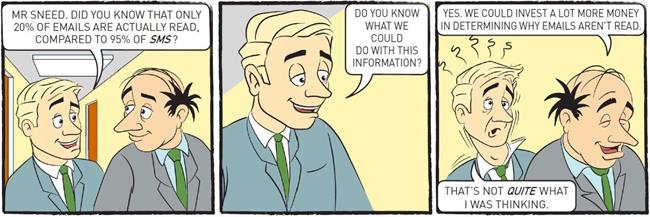
Later that day, Sam gets home and talks to his wife Jane and his grandmother - known as Gran - about his struggle at work. They have an unusual solution to help get the message across to Mr. Sneed.
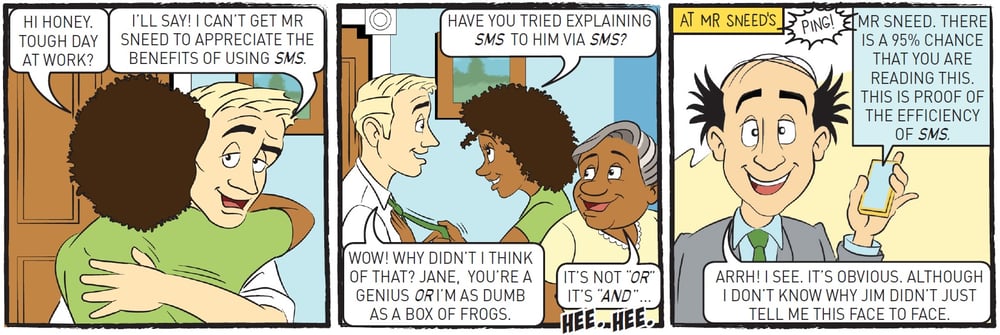
When Mr. Sneed receives a text message that displays the efficiency of SMS in action, it all suddenly makes sense to him.
Despite multiple surveys coming out that identify the unparalleled engagement opportunities of SMS, most enterprises today are still making the mistake of investing in the latest eye-catching apps, email or voice solutions. They should, instead, consider how digitally smart, interactive SMS can help connect with customers, while benefitting the bottom line as a cost-saving tool.
Many of us have found ourselves in a similar situation to Sam - or at one time have thought like Mr. Sneed. Sometimes, you have to see the results firsthand to believe them.
The Benefits Of Mobile Shopping With SMS
We've gotten the chance to see Gran's sense of humor, and this month, we also get a glimpse of just how tech savvy she is as she makes an online purchase entirely on her mobile device.
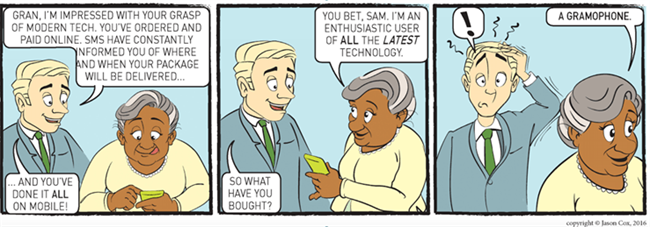
On top of maneuvering the online shopping experience seamlessly, Sam is also impressed that Gran has not only discovered how to, but actively kept up on, tracking the status of her digital purchase via SMS.
However, Sam is left scratching his head when Gran reveals to him what she's so intent on tracking until it arrives on the doorstep: A gramophone.
Gran is not only technically advanced, but she must have purchased her gramophone from a digitally savvy retailer as well. Research shows that despite an overwhelming preference by consumers for notifications via SMS, only the most innovative of retailers are currently taking note.
In fact, 77 percent of consumers today are likely to have a positive perception of a company that offers texting as an engagement channel for notifications like package delivery updates, sales announcements, discounts and authentication codes. This is largely due to people's preferences for text messaging in general. Ninety-seven percent of U.S. smartphone owners text at least once a day, and they open their messages within 90 seconds of receiving them.
However, an astounding 71 percent of retailers are currently not addressing their customers' communication preferences, and consumers are becoming overwhelmingly frustrated with being tied to a phone or computer for customer service needs. In a recent poll, 79 percent of retailers that used SMS with consumers saw either an increase in revenue or improved customer experience.
Find out other ways SMS can be harnessed for business and tune in for next month's final installment: Sam's wife shows him a thing or two about choosing the right supplier.
When It Comes To SMS, Content Is Key
SMS provides a convenient, accessible channel for companies to send their customers timely notifications, reminders, and even rewards like coupons and discount codes. The use of SMS creates this opportunity for a better customer experience, but like many aspects of marketing, content is key, and sending the right message at the right time means ever more. Content must be not only timely, but relevantly on point - or companies run the risk of losing their customers' trust.
Let's turn to Sam for a prime example of appropriate business-to-consumer SMS engagement in action.
Sam received a text message the other day letting him know when a plumber would arrive to fix his leaky sink. He was impressed by his plumbing company's innovative use of SMS technology to confirm the details of the appointment.
Upon reading the message, Sam realized his plumber gave him a vague timeframe and very little details in the text message. Sam's wife Jane, however, quickly tracked down another plumber that text back almost immediately with a personalized message providing his name, qualifications and the exact day/time he will call to arrange an appointment. Needless to say, the second plumber won the customer.
Businesses that use text messaging to reach their customers can greatly benefit from the immediate and interactive channel. Not all companies, however, understand how to use this technology effectively and fail to deliver the relevant content and information that the consumer cares most about. The key to achieving an effective mobile strategy is showing empathy - and this means sharing the right message to the right people exactly when they need it. It's critical for a business to utilize the most effective communication channel that's optimal for each point in the customer journey for each type of customer, but it's even more important that the content they share is relevant, specific and actionable.
SMS is a helpful tool for businesses, especially when it comes to sending appointment reminders and sharing information with customers. Not only does it reduce a business' no-show rate, but it significantly boosts customer satisfaction and loyalty.
Now let's pick back up with Sam to see more real-world examples of innovative ways companies are harnessing SMS today.
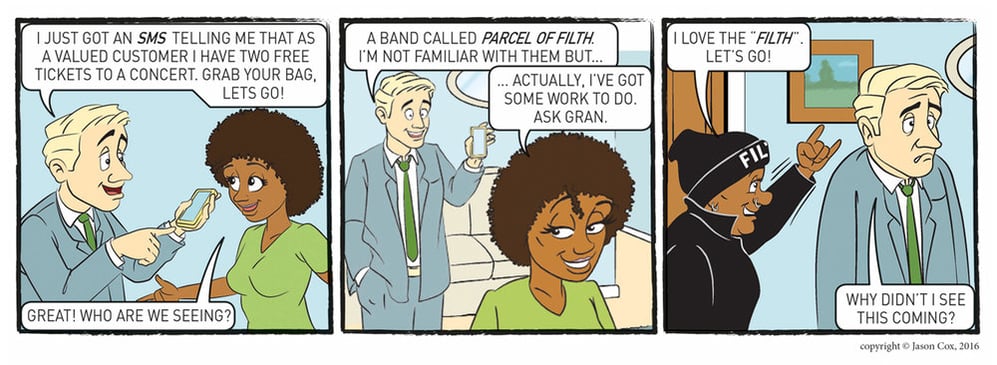
Sam experienced another benefit of SMS when he received a surprise loyalty reward via text - two free tickets to see the little-known band, 'Parcel of Filth.' Jane politely declined his invite, but to his surprise, Gran is a 'Filth' fan and happily accepted the ticket.
Just like Sam, nearly half of U.S. Internet users prefer receiving loyalty-related messages via SMS. For example, consumers can receive updates on the delivery status of their purchased items. These personalized updates can be instantaneously sent to a mobile device, and all the user needs to do is simply flash the phone to redeem. SMS is even a natural fit for letting loyal customers know when their favorite item is on backorder, is now in stock, or that their item is on its way. Text messaging can also be used to gather instant feedback via SMS surveys.
Conclusion
SMS offers companies unparalleled opportunities to interact with their customers, however, a business' messaging strategy must be implemented correctly to convey the right message at the right time. I hope Sam's journey with SMS has helped bring the technology to life in a fun light. Next time you get that appointment reminder, package tracking update, or flight information, don't just think of Sam, think of your customers and how they can benefit from empathetic mobile engagement.

Subscribe to Our Newsletter!
Latest in Mobile Marketing








